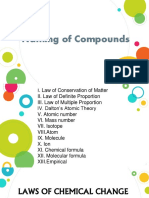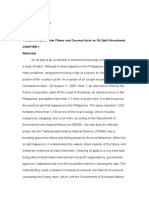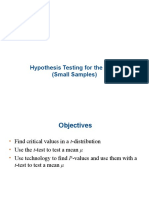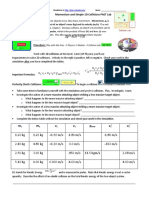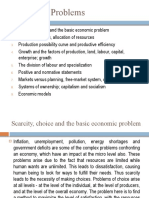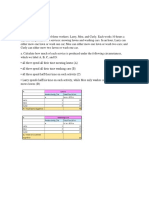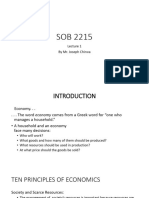100%(4)100% found this document useful (4 votes)
3K viewsEconomic Problems
Economic Problems
Uploaded by
chaitu34This document discusses key economic problems including scarcity, choice, opportunity costs, production possibility curves, factors of production, division of labor, positive and normative statements, and different systems of ownership. Scarcity arises due to limited resources and unlimited wants, forcing individuals and societies to make choices. Opportunity costs represent the best alternative forgone when making a decision. Production possibility curves illustrate the maximization of output from given resources.
Copyright:
Attribution Non-Commercial (BY-NC)
Available Formats
Download as PPTX, PDF, TXT or read online from Scribd
Economic Problems
Economic Problems
Uploaded by
chaitu34100%(4)100% found this document useful (4 votes)
3K views26 pagesThis document discusses key economic problems including scarcity, choice, opportunity costs, production possibility curves, factors of production, division of labor, positive and normative statements, and different systems of ownership. Scarcity arises due to limited resources and unlimited wants, forcing individuals and societies to make choices. Opportunity costs represent the best alternative forgone when making a decision. Production possibility curves illustrate the maximization of output from given resources.
Copyright
© Attribution Non-Commercial (BY-NC)
Available Formats
PPTX, PDF, TXT or read online from Scribd
Share this document
Did you find this document useful?
Is this content inappropriate?
This document discusses key economic problems including scarcity, choice, opportunity costs, production possibility curves, factors of production, division of labor, positive and normative statements, and different systems of ownership. Scarcity arises due to limited resources and unlimited wants, forcing individuals and societies to make choices. Opportunity costs represent the best alternative forgone when making a decision. Production possibility curves illustrate the maximization of output from given resources.
Copyright:
Attribution Non-Commercial (BY-NC)
Available Formats
Download as PPTX, PDF, TXT or read online from Scribd
Download as pptx, pdf, or txt
100%(4)100% found this document useful (4 votes)
3K views26 pagesEconomic Problems
Economic Problems
Uploaded by
chaitu34This document discusses key economic problems including scarcity, choice, opportunity costs, production possibility curves, factors of production, division of labor, positive and normative statements, and different systems of ownership. Scarcity arises due to limited resources and unlimited wants, forcing individuals and societies to make choices. Opportunity costs represent the best alternative forgone when making a decision. Production possibility curves illustrate the maximization of output from given resources.
Copyright:
Attribution Non-Commercial (BY-NC)
Available Formats
Download as PPTX, PDF, TXT or read online from Scribd
Download as pptx, pdf, or txt
You are on page 1of 26
At a glance
Powered by AI
The key takeaways are that resources are scarce while wants are unlimited, leading to economic problems like inflation, unemployment, and the need to make choices about what to produce.
Some of the economic problems discussed are inflation, unemployment, pollution, energy shortages and government deficits. These problems arise due to scarce resources and unlimited wants.
Scarcity leads to the necessity of making choices because resources are limited but wants are unlimited. This causes dissatisfaction and people need to decide how to fulfill their needs given the constraints.
Economic Problems
1.Scarcity, choice and the basic economic
problem
2.Opportunity costs, allocation of resources
3.Production possibility curve and productive
efficiency
4.Growth and the factors of production, land,
labour, capital, enterprise; growth
5.The division of labour and specialization
6.Positive and normative statements
7.Markets versus planning, free-market
system, command economy
8.Systems of ownership; capitalism and
socialism
9.Economic models
Scarcity, choice and the basic
economic problem
Inflation, unemployment, pollution, energy
shortages and government deficits are
some of the complex problems confronting
an economy, which have an impact at the
micro level also. These problems arise due
to the fact that resources are limited while
human wants are unlimited. This leads to
dissatisfaction, causing human being to
look for ways to fulfill their needs. Thus
scarcity leads to the necessity of making
choices. Problems of choice arise at all
levels - at the level of the individual, at the
level of producers, and at the level of the
overall economy. The problem here is to
Scarcity results when natural resources, human resources
and capital resources are not available in sufficient
quantity to satisfy all wants. So a producer has to decide
what he wants to produce using a particular resource. For
example, if he chooses to produce paper for textbooks
from a stand of trees, then no other product can be
produced from that particular stand of trees. Yet, there are
many other products that could have been produced using
the same natural resource, which are also desired by
consumers. The opportunity cost of the decision thus
becomes an important consideration; by making a choice,
the next best alternative good cannot be produced.
Consumers typically make their decisions based on two
considerations- budget constraints and personal
preferences. A budget constraint is the difficulty a person
faces when he tries to satisfy his unlimited wants with a
limited income. Thus, a purchase decision is based on
income, price, and personal tastes and preferences.
A consumer can have a choice of alternative products with a
limited income if he can find a person with whom he can
exchange goods or services. By means of such exchanges,
he can increase his level of satisfaction. Such gains in
satisfaction can be termed as ‘gains from trade’.
Such exchanges are also possible for producers. Although
two producers may both be capable of producing two
To make the best use of economic resources, the following questions
need to be answered:
What to produce?
How to produce?
For whom to produce?
These questions need to be asked because resources are scarce,
and can be put to alternative uses. Let us now examine these
questions in greater detail.
What to produce?
At the level of the government, scarcity of land, labor and capital
means that they cannot satisfy all the needs of the economy.
They have to choose which goods and services to produce, with
the limited resources available. From an individual’s point of
view, he or she has to decide how much to consume and how
much to save.
How to produce?
This looks at the combination of resources and the quantity of each
resource to be used to produce a given level of output. The best
combination is the full employment of the available resources, to
produce the maximum output. Depending on the resources
available, techniques of production can be labor intensive or
capital intensive.
For whom to produce?
This refers to the distribution of goods and services between
Opportunity costs, allocation of
resources
Opportunity cost can be defined as the cost of any
decision measured in terms of the next best
alternative, which has been sacrificed. To illustrate
the concept better, let us assume that a person who
has Rs. 100 at his disposal can spend it on either of
the three options: having a dinner at a restaurant,
going for a music concert or for a movie. The person
prefers going for a dinner rather than to the movie,
and the movie over the music concert. Hence, his
opportunity cost is sacrificing the movie, the next
best alternative once he goes for a dinner. If we carry
forward the same example at the firm level, a
manager planning to hire a stenographer may have
to give up the idea of having an additional clerk in
the accounts department. This is applicable even at
the national level where the country allocates higher
defense expenditures in the budget at the cost of
using the same money for infrastructural projects. In
order to maximize the value of the firm, a manager
must view costs from this perspective.
Production possibility curve and
productive efficiency
Now let us analyze how individuals, producers and other
economic agents use the scarce resources to meet the
unlimited needs. This to a large extent is possible with the
help of the production possibility curve (PPC). The
production possibility curve can be defined as a curve
which shows the maximum combination of output that the
economy can produce using all the available resources.
The production possibility curve helps us understand the
problem of scarcity better, by showing what can be
produced with given resources and technology. Technology
is the knowledge of how to produce goods and services.
The following assumptions are made in constructing a
PPC:
The economic resources available for use in the year are
fixed.
These economic resources can be used to produce two broad
classes of goods.
Some inputs are better used in producing one of these
classes of goods, rather than the other.
Growth and the factors of production,
land, labour, capital, enterprise; growth
The division of labour and specialization
Positive and normative
statements
Another debate about the nature of economics is
whether it is a positive or a normative science.
According to J. M. Keynes, “A positive science may be
defined as a body of systematized knowledge
concerning what is. A normative science or regulative
science is a body of systematized knowledge relating
to the criteria of what ought to be and concerned with
the ideal as distinguished from the actual.....The
objective of a positive science is the establishment of
uniformities; of a normative science, the
determination of ideals.”
Positive economics explains economic phenomena
according to their causes and effects. At the same
time, it says nothing about the ends; it is not
concerned with moral judgments. On the other hand,
normative economics explains how things ought to
be. According to Milton Freidman, positive economics
deals with how an economic problem is solved;
normative economics on the contrary deals with how
Markets versus planning, free-
market system, command
economy
Market Economy
This economic system emphasizes the freedom of
individuals as consumers and suppliers of resources,
and allows market forces to determine the allocation
of scarce resources through the price mechanism.
Based on market demand and supply, consumers are
free to buy goods and services of their choice and
producers allocate their resources based on the
demand. Decisions made by producers and
consumers are influenced greatly by price.
Price plays a major role in a market economy. The role
of the government is negligible: consumers choose
the goods they want and producers allocate their
resources based on the market demand for different
products.
In such a system, efficiency is achieved through the
profit motive. Producers make goods at the lowest
cost of production, and consumers get higher value
goods and services at lower prices. The United States
Command Economy
In a command economy, all the economic
decisions are taken by the government – what
to produce, how to produce and for whom to
produce. Thus, all decisions, from the
allocation of resources to the distribution of
end products, is taken care off by the
government. In this type of systems, efficiency
can be achieved only when demands are
accurately estimated and resources allocated
accordingly. The USSR was an example of a
command economy. The government had
complete control over the economy, and
consumers were just the price takers. The
government set output targets for each district
and factory and allocated the necessary
resources.
Incomes are often more evenly distributed in a
command economy, in comparison to other
types of economies. Prices are controlled and
this allows for greater equality in the economy.
Mixed Economy
A mixed economy is a combination of a free
market economy and a command economy.
Here, government controls the price
fluctuations to achieve certain objectives
such as high level of employment and low
level of inflation. A mixed economy uses
cost-benefit analysis to answer the
fundamental questions discussed earlier -
what, how, and for whom to produce. A
cost benefit analysis helps to assess the full
costs and benefits to society arising from a
particular decision or project. Decisions or
projects affecting the economy as a whole
are taken or accepted only when the social
benefits from the decision of project are
greater than the social costs.
In a mixed economy, the government
organizes the manufacture or provision of
Economic models
Economic models is a set of equations or relationships
used to summarize the working of the national
economy or of a business firm or some other
economic unit. Models may be simple or complex
and they are used to illustrate a theoretical principle
or to forecast economic behavior.
Economic models can be further classified into Micro
Economics Models and Macro Economic Models.
Micro Economic Models: Models when they incorporate
individual economic units such as households and
firms, often grouped into individuals markets and
industries and the relationship between them are
called as micro models.
Macro Economic Models: these models are used to
explain and predict the working or performance of
the economy as a whole, e.g changes in the level of
NI, the level of employment and inflation.
What Economists Do
The economy can be looked at with either
a micro or a macro view.
Microeconomics vs.
Macroeconomics
What Economists Do
Microeconomics and Macroeconomics
Microeconomics is the study of
individual people and businesses and the
interaction of those decisions in the
market.
Studies:
Prices and Quantities
Effects of government regulation and taxes
What Economists Do
Microeconomics and Macroeconomics
Macroeconomics is the study of the
national economy and the global
economy as a whole.
Studies
Average prices and total employment,
income, and production
Effects of taxes, government spending , a
budget deficits on total jobs and incomes
Effects of money and interest rates
Economic Science
Economists attempt to discover an
explanation for how economic systems
work.
Economists distinguish between Positive
Statements and Normative Statements
Economic Science
Positive statements are about what is.
can be proven right or wrong
can be tested by comparing it to facts
Normative statements are about what
ought to be.
depend upon personal values and cannot
be tested
MARGINAL VALUE
The marginal value of a
dependent variable is the change
in this dependent variable
associated with a 1-unit change
in a particular independent
variable
Maximization occurs when
marginal switches from positive to
negative.
If marginal is above average,
average is rising.
If marginal is below average,
average is falling.
Graphing Total, Marginal, and
Average Relations
Deriving Totals from Marginal and Average
Curves
Total is the sum of marginals.
Relationship between output and profit
Total, marginal, and average profit
Incremental Concept in Economic
Analysis
Marginal v. Incremental Concept
Marginal relates to one unit of output.
Incremental relates to one managerial
decision.
Multiple units of output is possible.
Incremental Profits
Profits tied to a managerial decision.
Incremental Concept Example
You might also like
- Energy and EnvironmentDocument179 pagesEnergy and Environmentdanielsahle1746No ratings yet
- Economics 1A and B Workbook PDFDocument90 pagesEconomics 1A and B Workbook PDFJOHN50% (4)
- Exam Sana 2Document5 pagesExam Sana 2Mahmoud HamedNo ratings yet
- Extra Percent Yield Problems AnswersDocument1 pageExtra Percent Yield Problems AnswersCharls John ErcilloNo ratings yet
- Chapter 1 - MMWDocument34 pagesChapter 1 - MMWMina SaflorNo ratings yet
- Understanding Student's Choice of School and Marketing Strategies of JRLMHSDocument47 pagesUnderstanding Student's Choice of School and Marketing Strategies of JRLMHSCrizel Anne MactalNo ratings yet
- Conversion & Scientific NotationDocument32 pagesConversion & Scientific NotationStephen AbadinasNo ratings yet
- Module 1Document15 pagesModule 1Ann BombitaNo ratings yet
- Physical Science ReviewerDocument2 pagesPhysical Science ReviewerKaren Joy BaloloNo ratings yet
- General Chemistry 1Document43 pagesGeneral Chemistry 1Reynail SumayaNo ratings yet
- Questionnaire SpendingDocument4 pagesQuestionnaire SpendingNslaimoa AjhNo ratings yet
- Chemistry 1 - 11 - Q1 - M8Document14 pagesChemistry 1 - 11 - Q1 - M8Elisa PauloNo ratings yet
- Inverse Tangent and Other Inverse FunctionsDocument24 pagesInverse Tangent and Other Inverse Functionsfayelopez729No ratings yet
- Latest Tech Quiz Questions and Answers 2018Document5 pagesLatest Tech Quiz Questions and Answers 2018melba escuetaNo ratings yet
- Alejandrino Abm12-3 Lesson4-6 Hbm122Document4 pagesAlejandrino Abm12-3 Lesson4-6 Hbm122Rence AlejandrinoNo ratings yet
- ClaimdatawarrantDocument18 pagesClaimdatawarrantapi-257649366100% (1)
- MMW Activity 4Document4 pagesMMW Activity 4Riane Angelie SaligNo ratings yet
- Essay - Example - University AssignmentsDocument5 pagesEssay - Example - University Assignmentsjeni_parryNo ratings yet
- LESSON 1 - General Physics 11Document28 pagesLESSON 1 - General Physics 11nadeksjwjNo ratings yet
- REVISED PHYS 11 - CoursepackDocument268 pagesREVISED PHYS 11 - CoursepackcliermanguiobNo ratings yet
- STAT2303 UARK: Hypothesis Testing WorksheetDocument2 pagesSTAT2303 UARK: Hypothesis Testing WorksheetTodd ThomasNo ratings yet
- Quarter 4, LAS 1: Power of Media and InformationDocument26 pagesQuarter 4, LAS 1: Power of Media and InformationFrancis Palomar DolleroNo ratings yet
- Percent Composition and FormulasDocument15 pagesPercent Composition and FormulasJosh CRNo ratings yet
- Not Your Typical Reviewer 2Document1 pageNot Your Typical Reviewer 2Mo PadillaNo ratings yet
- Generally Accepted Accounting Principles (GAAP)Document4 pagesGenerally Accepted Accounting Principles (GAAP)Sakata369100% (1)
- Canete DocsDocument2 pagesCanete DocsWenceslao Cañete IIINo ratings yet
- Food Chains Webs Trophic LevelsDocument23 pagesFood Chains Webs Trophic Levelsapi-536437763No ratings yet
- Grounded Theory For ABMDocument24 pagesGrounded Theory For ABMCrizelda RadaNo ratings yet
- Essay CalculusDocument4 pagesEssay Calculuslolipop_leomia123320% (1)
- Calculus Cheat Sheet LimitsDocument2 pagesCalculus Cheat Sheet LimitsJuan Carlos BetancurNo ratings yet
- Naming of CompoundsDocument59 pagesNaming of CompoundsidrkNo ratings yet
- Chapter 1Document6 pagesChapter 1Angelica TebelinNo ratings yet
- Group 2 Physical ScienceDocument10 pagesGroup 2 Physical ScienceJay Em Kristel MengulloNo ratings yet
- Lesson2 Importance of QR Across FieldsDocument12 pagesLesson2 Importance of QR Across Fieldsmargilyn ramosNo ratings yet
- Module 4 PDFDocument5 pagesModule 4 PDFIsrafel CariagaNo ratings yet
- Types of ScalesDocument8 pagesTypes of ScalesBahrouniNo ratings yet
- Jayson UCSP Week 9 & 10Document2 pagesJayson UCSP Week 9 & 10Jayson P. JalbunaNo ratings yet
- Computing The Variance of A Discrete Probability DistributionDocument12 pagesComputing The Variance of A Discrete Probability Distributionhey heyNo ratings yet
- Contemporary Economic Issues Facing Filipino EntrepreneurDocument18 pagesContemporary Economic Issues Facing Filipino Entrepreneursheisbonjing PHNo ratings yet
- Brief Introduction: TD-BED 02 Modified Learning Materials/Modules Based On The Deped CurriculumDocument12 pagesBrief Introduction: TD-BED 02 Modified Learning Materials/Modules Based On The Deped Curriculumgemma marcitoNo ratings yet
- Final PRDocument85 pagesFinal PRAlison ManansalaNo ratings yet
- SPTC 0203 Q3 FPFDocument27 pagesSPTC 0203 Q3 FPFLove the VibeNo ratings yet
- Case Study #1: The Toy Manufacturer's Dilemma: The Current Chemical and Toys To Be Unsafe. Consequently, SuchDocument6 pagesCase Study #1: The Toy Manufacturer's Dilemma: The Current Chemical and Toys To Be Unsafe. Consequently, SuchMarielle AngelesNo ratings yet
- Statistics and Probability Chapter 1 2 3Document89 pagesStatistics and Probability Chapter 1 2 3Ren PonceNo ratings yet
- Finance An Art or ScienceDocument17 pagesFinance An Art or Sciencegcc vehariNo ratings yet
- The Effect of The TeacherDocument7 pagesThe Effect of The TeacherVergel MartinezNo ratings yet
- COLLARTE, JANDONERO, LOPEZ, The Efficiency of Palm Fibers and Coconut Husk As Oil Spill AbsorbentsDocument10 pagesCOLLARTE, JANDONERO, LOPEZ, The Efficiency of Palm Fibers and Coconut Husk As Oil Spill AbsorbentsJosh LopezNo ratings yet
- FInancial Literacy Research-Proposal - Educ-609Document2 pagesFInancial Literacy Research-Proposal - Educ-609Fatima Portillo CaroNo ratings yet
- Hypothesis Testing For The Mean (Small Samples)Document40 pagesHypothesis Testing For The Mean (Small Samples)ANCHURI NANDININo ratings yet
- Avogadro LawDocument10 pagesAvogadro LawLerr Real RelleNo ratings yet
- Thesis Title For Financial Management StudentsDocument8 pagesThesis Title For Financial Management StudentsAsia Smith100% (2)
- C - 1D Collisions PhET LabDocument2 pagesC - 1D Collisions PhET Labcaleb fNo ratings yet
- Effects of Intermolecular Forces Part 1Document1 pageEffects of Intermolecular Forces Part 1Sonoko SuzukiNo ratings yet
- Chemistry Octet RuleDocument1 pageChemistry Octet RuleBeti PerezNo ratings yet
- Level of Academic Performance Among Senior High School Students A Differential StudyDocument5 pagesLevel of Academic Performance Among Senior High School Students A Differential StudyPsychology and Education: A Multidisciplinary JournalNo ratings yet
- Problem - 4A PDFDocument5 pagesProblem - 4A PDFMonicaNo ratings yet
- Probability and Non Probability of SamplingDocument17 pagesProbability and Non Probability of SamplingLillon JayyNo ratings yet
- Photon Theory of LightDocument15 pagesPhoton Theory of LightShenami SathurdeiNo ratings yet
- Practical Research Week 1Document20 pagesPractical Research Week 1Presydente100% (1)
- Economic Problem SDocument26 pagesEconomic Problem SManish MishraNo ratings yet
- EconomicsDocument12 pagesEconomicsSaranya PugazhenthiNo ratings yet
- BIT 2120 Econ Notes 1Document24 pagesBIT 2120 Econ Notes 1kelvinkakuru2No ratings yet
- Trade - Factor Availability and Factor Proportions Are KeyDocument16 pagesTrade - Factor Availability and Factor Proportions Are Keyمحمد علاء مصريNo ratings yet
- Exercise 2 Basic Concepts and Problems of EconomicsDocument3 pagesExercise 2 Basic Concepts and Problems of EconomicsHui QingNo ratings yet
- Economic ModelsDocument7 pagesEconomic ModelsHelena MontgomeryNo ratings yet
- Production Possibility CurveDocument6 pagesProduction Possibility CurveGirish kishoreNo ratings yet
- Chapter 1 Introduction To EconomicsDocument25 pagesChapter 1 Introduction To EconomicsNur FadzilahNo ratings yet
- Assignment 2Document6 pagesAssignment 2ShubhamJainNo ratings yet
- Ppf-Opportunity CostDocument17 pagesPpf-Opportunity CostLeo SuingNo ratings yet
- Economics Class NotesDocument4 pagesEconomics Class NotesMadeleine ThomasNo ratings yet
- EcoDocument112 pagesEcoYash Bajaj100% (1)
- Chapter 02 Foundations of Modern Trade TheoryDocument24 pagesChapter 02 Foundations of Modern Trade Theorytbear232No ratings yet
- Lecture 2: One-Factor Economy: The Ricardian Model: Ntuyen@hcmiu - Edu.vnDocument37 pagesLecture 2: One-Factor Economy: The Ricardian Model: Ntuyen@hcmiu - Edu.vnLiễu Uyên VũNo ratings yet
- Austrian Theory of The Trade Cycle (Roger Garrison)Document48 pagesAustrian Theory of The Trade Cycle (Roger Garrison)Guillermo ApazaNo ratings yet
- ECO 100Y Introduction To Economics Midterm Test # 1: Last NameDocument13 pagesECO 100Y Introduction To Economics Midterm Test # 1: Last NameexamkillerNo ratings yet
- Macro Tut 9Document7 pagesMacro Tut 9Phạm Minh NgọcNo ratings yet
- HWK 2Document3 pagesHWK 2Ingrid Anaya MoralesNo ratings yet
- Lecture 1-SOB 2215 March 2023Document98 pagesLecture 1-SOB 2215 March 2023zulufelix029No ratings yet
- Basics of Micro EconomicsDocument13 pagesBasics of Micro EconomicsKabir Sai Prasanna Suryavansh100% (1)
- Unit 1 Microeconomics Sample Questions Multiple ChoiceDocument11 pagesUnit 1 Microeconomics Sample Questions Multiple ChoicebryanNo ratings yet
- EconomicsDocument33 pagesEconomicsghazanfar_ravians623No ratings yet
- Aqa Econ1 QP Jan12Document16 pagesAqa Econ1 QP Jan12api-247036342No ratings yet
- Quiz 2 With AnswerDocument1 pageQuiz 2 With AnswerJAZ2345No ratings yet
- Lesson 2 - Utility and Application of Applied Economics To Solve Economic Issues and ProblemsDocument22 pagesLesson 2 - Utility and Application of Applied Economics To Solve Economic Issues and ProblemsEfren VibasNo ratings yet
- Principles of Economics and Bangladesh EconomyDocument6 pagesPrinciples of Economics and Bangladesh EconomyZonal office ChapainawbagnajNo ratings yet
- Chapter 1& 2Document24 pagesChapter 1& 2Michael GezahegnNo ratings yet
- EconomicsDocument22 pagesEconomicsShonit kediaNo ratings yet
- Introduction To Microeconomics Booklet 2Document120 pagesIntroduction To Microeconomics Booklet 2Salifyanji SimwakaNo ratings yet
- Chap 002Document31 pagesChap 002yoshiNo ratings yet
- Ap17 Macroeconomics q3 PDFDocument6 pagesAp17 Macroeconomics q3 PDFDion Masayon BanquiaoNo ratings yet






























